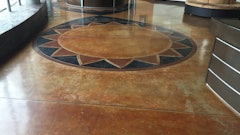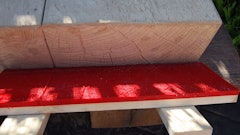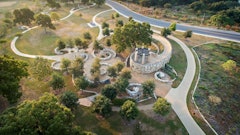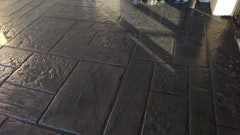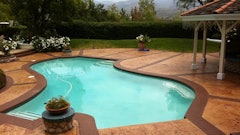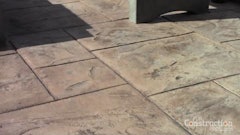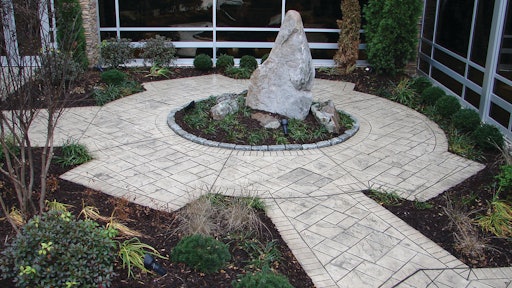
When it comes to stamping, there are numerous products available. And they are just as diverse as the patterns they can stamp. Stamping can make a job unique and leave an impression on those who see the work. Stamping products on the market today allow contractors different options not only in the tools they use but also in the process of stamping the concrete.
DEREU DECORATIVE CONCRETE
Mike DeReu, owner of DeReu Decorative Concrete, has been involved in the decorative concrete business for 18 years. Ninety-five percent of his work is in stamping, mostly residential, but DeReu says his company has recently started in concrete staining as well. No matter what job DeReu and his employees are working on, though, they use only Proline tools to get the work done.
DeReu Decorative Concrete does most of its work in Illinois, and in the summer of 2007, DeReu and his crew completed a combination patio and driveway stamping job there. The 3,000-sq.-ft. job took three weeks for the crew of five to complete, according to DeReu. The stamping totaled about six days of work.
DeReu says the crew spent a lot of time with prep work. Before the new concrete could be poured, part of the driveway had to be torn out. A ¾-in. gravel with fines was used and compacted for the base, and then 3/8-in. rebar was placed. After that, the crew poured the concrete - a mix of 4,000 psi concrete with big rock and fiber.
The next step was to add the color hardeners and release agents. DeReu says they used a throw-on color hardener that was dusted on twice. Different colored Proline powder release agents were also used. These included a beige color as well as a terra-cotta release, DeReu says. Standard finishing techniques were used before the crew stamped the job.
The stamping was a very involved process. It required the use of multiple Proline stamps, according to DeReu: an Arizona Flagstone, an Ashlar Slate, a European Fan, and a Rose Vine Border stamp. "The border tools are just outstanding," he says. "Stamping a job from edge to edge is one thing, but to add the border art on a job, that just makes the job."
After stamping was complete, DeReu and his crew used Proline's EZ Tique staining system to highlight different colors in different areas of the patio and driveway.
DeReu is not shy about promoting the use of Proline stamps. He says the stamps are easy to run on long stretches of concrete. "You can run their monster stamps, like their square patterns, 40 to 50 feet long and you can stay straight as an arrow," he says. "They're engineered to work, and they just lock together so much nicer and stamp so much nicer."
Plus, DeReu says, the stamps offer a nice realistic look.
STAMPED CONCRETE LLC
For Stamped Concrete LLC, stamping comprises 80 percent of the company's work, according to owner Dave Edwards. The company does both residential and light commercial work. And although it offers customers a range of decorative work, stamping is its main business.
Instead of using the traditional stamping mat and tamper to imprint a pattern on concrete. Edwards uses the Rock'N'Roller sold through Cleform Tool Corp. The Rock'N'Roller, as its name suggests, is a stamp that you roll on the concrete. And the roller does not require a contractor to be directly on the concrete in order to stamp.
"That's really where the advantage is for the roller," he says. "You don't have to get on the concrete physically yourself. It just rolls across the surface. With the mats, you have to walk out on the concrete when it's at the exact right firmness, and then you have to tamp the stamps in. So it takes quite a bit more labor - bending, picking up, moving these stamps. With the roller you just roll it across the top, a guy moves it over and you roll it back. That's kind of why we went to it. You are done before you could even lay your first mat down. Running your own business this is money in your pocket," he says.
Stamped Concrete LLC has been using the roller to stamp jobs for the last three years. Edwards says the roller not only makes stamping easier, but it allows him to stamp a larger area. "All I could stamp [with traditional mats] at a time was about eight to 10 yards with nine guys," he says. "Now I'm able to take the roller and stamp 20 and 30 yards and do it with seven guys."
Two years ago, Edwards used the Rock'N'Roller to stamp a driveway in Oak Grove, Mo. The job took six days to complete and required around 530 yds. of 4-in.-thick colored concrete. The integral color, made by Symons, was mixed into the 4,000 psi concrete mix in the truck before it was poured, Edwards says. The mix had 6 percent air entrainment and also contained microfibers to help the surface from popping.
The first day on the job was spent grading and setting the forms. Rebar was used to reinforce the concrete. By the second day, the crew was ready to pour. The pouring spanned four days, with the largest pour being 125 yds. of concrete in just one day, Edwards says. "The most I've ever poured with a mat was 50 yards in a day, and I had 12 guys when I did that. And I only had seven guys on this project with the roller."
The concrete was troweled and then finished. The stamping was done while the concrete was still wet. "If you're using a roller the key is to stamp it wet enough. If you wait too long you're not going to get a good, consistent print," Edwards says.
To give the driveway an antique look, a powdered Symons antiquing release was mixed with a clear liquid Rock'N'Roller release and sprayed on, according to Edwards. A light tan or light buff color was used in the concrete and a walnut color was used for the antique look, he says.
Despite the ease of using the Rock'N'Roller, Edwards says there were still challenges he and his employees had to face. First of all, the size of the job was far larger than the average driveway Stamped Concrete LLC usually does - 12 yds. of concrete is the norm for the company.
The driveway was set up on a hill where wind became a factor. The crew had to be concerned with the release blowing away. To solve this problem, Edwards says they used a spray system for the roller. "You can put a backpack sprayer on it and it has a coil hose that hooks to it, and it sprays directly off the roller so you're not losing your release," he explains.
The fact that the concrete could be rolled while it was still wet also helped in the windy conditions, which caused the concrete to dry faster. "With the roller compared to the mats you're stamping it so much wetter," he says. "You spray your release on it, and roll it, and you're done because you're not putting all that weight on there."
Despite the job being so large, Edwards still stays it was a pretty simple job. And he says it stands out as one of the best projects the company has done thanks to the Rock'N'Roller.
SPECIALTY CONCRETE SERVICES
Another unique product that gives similar results as stamping concrete is the ArtCrete Faux Brick Stencils. The stencils can be used in the same areas as stamps, and they create a similar look to stamping mats. Merrick Pierce, owner of Specialty Concrete Services, has been in business for 12 years and has used the ArtCrete stencils since he started.
The stencil produces a pattern and texture similar to stamping, but through a different process. First, Pierce says you roll out the 3-ft.-wide stencil to the width of the slab and lay it down. "We use a large textured paint roller to actually roll over the stencil to slightly embed it into the concrete," he says. When comparing the stenciling technique to stamping, the roller performs a similar role as the hand tamp does with stamping mats. Pierce says you continue this process until the entire slab is covered.
In 2005, Pierce's company used ArtCrete stencil products to create a memorial for a former dean at Northwestern State University in Natchitoches, La. The job, which included taking out and replacing concrete sidewalks in addition to pouring and stenciling the concrete memorial, took five days to complete and required 30 yds. of concrete.
The triangular shaped memorial was stenciled a different pattern than the sidewalks in order to keep the sidewalk area distinguishable. For the sidewalks, Pierce used an Old Chicago Brick pattern with a border while a slate pattern was used for the actual memorial area.
After tearing out the existing sidewalks, the new sidewalks were formed and poured. Then the concrete for the memorial area was poured and finished with a bull float. After that, the stencils were placed. Pierce then used a paint roller to embed the patterns into the sidewalk and memorial.
The next step was to apply an ArtCrete dry shake color hardener to the concrete. Two colors, black and red, were used on both the sidewalks and the memorial, Pierce says. To make sure the sidewalks and memorial area were noticeably different, the black color was made more dominant on the sidewalks. After applying the color hardener, the concrete was troweled and then a clear liquid ArtCrete release agent was applied. Pierce says he prefers to use a liquid release instead of a powdered release because the liquid allows him to finish the job in one day instead of having to come back the next day and rinse off the powdered release.
Finally, the stencils were removed, and one final step was taken to give the pattern some texture. "After it is set up sufficiently, we generally use a texture roller, which ArtCrete manufactures, to roll over it to give it a light textured finish," Pierce says. For this particular project Pierce says a granite texture roller was used to complete the finish. "You'd consider stenciling a finishing process, but you would consider rolling a finishing process, too. So basically we're kind of combining two finishing techniques into one," he says.
One of the hardest parts of this job was the number of people who had input on the project. Pierce says he incorporated all the feasible ideas that he could, but ultimately could only do as much as the product could allow.
Both stencils and stamps have limitations, and Pierce doesn't necessarily believe one is better than the other. "Stencil has less touch up work then stamps, and it is probably faster than stamping on a wide open job," he says. "But, stamping is easier to do up against walls where you have obstructions on the sides of the job."
SITE TECHNOLOGIES INCORPORATED
When it comes to stamping jobs, Site Technologies Incorporated relies on L.M. Scofield products to get the job done. Site Technologies, a hardscapes contractor that offers package projects, employs around 150 people and does 100 percent of its business in the commercial market, according to vice president Lamar Moore.
Site Technologies started offering stamping to its package projects in 2000 and has been using L.M. Scofield stamping products since day one. In-house training was provided to give employees the skills and knowledge needed to use these stamping products. "We actually did demonstrations at our office. We got in the concrete; we played with the color; we did it all right there at our office facility," Moore says.
In October 2007, Site Technologies completed the Avenue at Murfreesboro, an open-air retail center in Tennessee. Part of this project included stamping 20,000 sq. ft. of pavement, says project manager Harley Ray.
The stamping portion of the project took about three weeks and 410 yds. of 8-in.-thick concrete to complete, Ray says. A French gray integral color from L.M. Scofield was mixed into the 4,000 psi concrete mix at the ready mix plant. Before the concrete could be poured the pavement had to be formed, the base material and rebar had to be placed, and the expansion joints had to be set. "We had a specific joint pattern provided by the architect to allow for expansion in the concrete," Ray says. "That joint pattern defined our pours."
Once the concrete was poured, it was finished with a bull float. Then a deep charcoal color hardener from L.M. Scofield was added and troweled in. The next step was to apply a deep charcoal colored powdered release also from L.M. Scofield to help keep the stamps from sticking to the wet concrete.
Ray says a three-piece L.M. Scofield pattern was used to stamp the concrete. The pavement was stamped in an Ashlar stone pattern using mats and a tamp to imprint the stamp. The release was washed off the day after an area was stamped. Finally, the project was sealed using a L.M. Scofield product that is a combination of curing compound and sealer, Ray says.
The site of the project provided some challenges. It was a wide open area with no shade. Wind was also a factor. The crew had to be concerned with the heat and wind because it caused the concrete to dry fast. To overcome these challenges, Ray says they tried to pour the concrete early in the morning. They also thoroughly wet the base material the night before to keep the moisture in the concrete. "Wetting the ground keeps your moisture in the concrete and helps prevent cracks from forming at the top due to all the moisture being sucked out the bottom from the dry ground," he says.
Ray's biggest piece of advice for contractors who may stamp a job similar to the Avenue at Murfreesboro is to pay attention to your environment. "Stamped concrete is very peculiar to the environment that it is placed in. You need to take measures to adjust your construction procedures accordingly," he says.
INCRETE OF MARYLAND INC.
Increte of Maryland was established in 1991 and has been doing decorative concrete work exclusively since 1995, says President Jim Moran. Stamping comprises about 75 percent of the company's business. Moran says the company has an average of 14 employees and runs two crews.
In May 2007, Increte of Maryland started a stamping project for a Westin hotel near the BWI Airport in Maryland, which consisted of a courtyard, patios, sidewalks and a portico-chere. The project required 104 cu. yds. of 4,000 psi concrete with fiber mesh, wire mesh, ½-in. rebar (16 in. on center) and a stone base, Moran says. It took Increte of Maryland 16 days to complete the project.
Moran says the courtyard was done first, and it was probably the most difficult part of the project. "The courtyard was elevated and there was no access to it.," he says.
Almost all the landscaping was done before Moran and his crew came in to start. After the landscaping was complete Increte of Maryland placed and compacted its stone base and installed all of the formwork.
Then the 4-in.-thick concrete was pumped into place. After using standard finishing techniques for the concrete, Moran says two coats of a Sun Buff shake-on color hardener were applied with the second coat being troweled into the concrete. "The reason we went with color hardener was because of the wearability. It gives you a much more wear-resistant surface, and also you're concentrating all your color on the surface verses integral dye," he says. Before the stamping was started, a powdered charcoal release was put on the concrete.
The courtyard was stamped using Increte stamping mats in an Old English Slate pattern with a Soldier Course Brick border. "We actually did them both at the same time. We ran the Soldier Course, left those stamps there, stamped our field, and when we picked up our field we moved the Soldier Course with it," he says. "This way we wouldn't get the field pattern out on the Soldier Course where we didn't want it."
After completing the courtyard the front sidewalks and portico-chere were poured and stamped in the same manner using a Diamond Slate pattern and the same color hardener and release. The sidewalks were poured 5-in. thick, and the portico concrete was 6-in. thick, he says.
The concrete for the entire project was poured and stamped in sections, and Moran says the day after stamping was done the crew installed the saw cut control joints. Finally, the release was washed off and the concrete was sealed with two coats of Increte clear seal.
One of the concerns when stamping concrete is timing the stamping just right. Moran says you don't want to start stamping when the concrete is too soft, but you don't want to wait too long either. "One of our little tricks is we always try to start in the sun and work toward the shade if you have that opportunity," he says. Using double sets of stamps also helps get the job done faster, he adds.
Moran says the most important parts of a stamping job are texturing, washing and sealing the project. It's the little things that make the job, he says. And a contractor who takes the time to strike out the joints where the stamps come together and finish off joints all the way to walls and forms will have a satisfying result at the end.






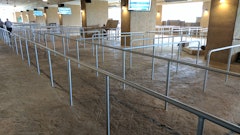
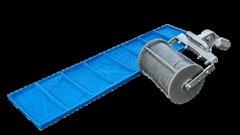

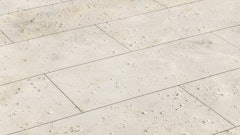


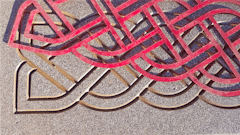


![[VIDEO] Proline Seamless Pattern Stamps at World of Concrete 2017](https://img.forconstructionpros.com/files/base/acbm/fcp/image/2017/02/default.58ab483ca69fc.png?auto=format%2Ccompress&fit=crop&h=135&q=70&w=240)

